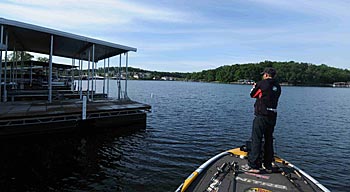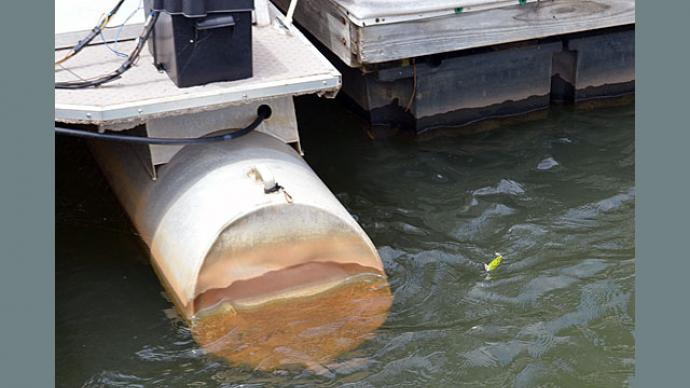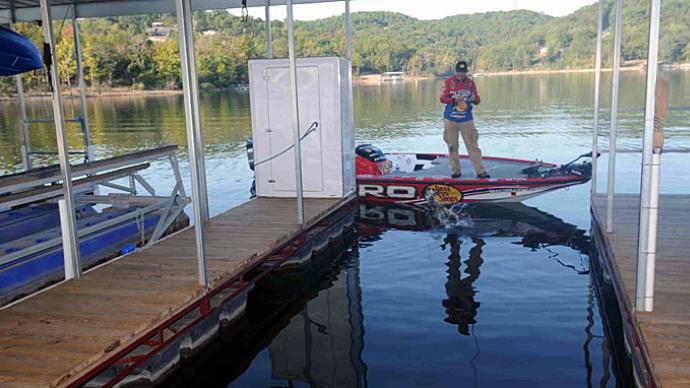
Boat docks are high-priority targets for Casey Scanlon whenever he practices for a tournament.
Scanlon admits targeting docks gives him confidence, primarily since he guides on Missouri’s Lake of the Ozarks, a 54,000-acre reservoir loaded with countless docks. So it is a given that the first piece of cover Scanlon checks out in practice will be a dock.
Throughout his pro career, Scanlon has fished many docks ranging from stationary wooden piers to floating structures secured with steel cables. Since he mainly fishes the floating-style boat houses around home, Scanlon’s tips for this article will focus on how to fish foam-floatation docks attached to steel cables.
The Bassmaster Elite Series pro considers docks ideal cover because the structures extend over a wide range of depths. “You can fish them from zero to 30 feet deep,” says Scanlon. “A lot of times homeowners put brush under them (a bonus piece of cover).” The boat houses also allow bass to move up and down in the water column where they can suspend under the foam of the floating structures or at a mid-depth range or hug the bottom.
Boat docks attract plenty of forage fish for bass too. “Every dock is going to have bluegill underneath it, and it is nice to find docks where the shad are congregating around as well,” Scanlon says. “There is always going to be bait present, mostly in the form of bluegill, which I think bigger fish prefer.”

Docks also create a lot of shade where bass can lurk and set up to ambush baitfish. “I always keep an eye on shade and am aware of it in case I start getting bites,” Scanlon says. “I always fish the shady side (of docks) a little bit harder,” Scanlon notes the only time he avoids the shady side of docks is during winter and early spring when bass seek warmer water. Then he keys on the sunny side of a dock, especially where the sunshine hits the black floatation, generating warmer water.
“An ideal dock to me is the biggest I can find without being a marina dock,” says Scanlon, who prefers large private docks that can cast ample shade.
The Missouri pro also favors fishing isolated docks, or if an area is loaded with boat houses, he keys on the first few docks heading into a creek, the last few docks in the back of a creek, or docks situated on a point or break line. “I rarely go down a row of 20 docks that are all in 15 feet of water,” he says.
Scanlon tries to pick out individual targets rather than fish a whole row when he has to fish an area with rows of docks. “I will side scan (the docks) with my Garmin electronics and look at my down view and see where the fish are positioned,” Scanlon says. “I am mostly looking for cover, so if one of the docks has a brush pile underneath, that is the one I am going to target. I also look for the biggest and ugliest ones with stuff falling off them. I also look for rod holders and fish baskets--just signs that a fisherman lives there.”
Docks are productive year-round for Scanlon, so here are his tips on how to fish this type of cover throughout the four seasons.
Winter
“A lot of the fish will either be around docks in the deep guts in the back of the creeks or isolated docks on a secondary point or the main lake,” Scanlon says. “I am looking for a dock with a lot of depth under it, and I am looking for a lot of shad. I look for docks where the fish don’t have to move much. If it is sunny, they can slide up in 10 feet of water, then slide back the other direction by 10 or 12 feet into depths of 30 to 40 feet. “
On extremely sunny days, Scanlon will fish the back side of docks along steep banks, but most of the time, he keys on the sides of docks or wherever he finds brush piles near the floating structure. “Bass like to suspend that time of year, so if there is some brush on the side or if there is a brush pile behind the dock, I will flip a jig there,” Scanlon says. He also concentrates on the front of large boat houses where bass hang around the steel cables that anchor the docks.
Spring

“I am looking for the transitions in the bank where the channel bank turns down into gravel, which is where the fish are looking to spawn,” Scanlon says. “So I like docks situated close to the bank, especially if the back of the dock is up on the bank.” He believes bass flock to these shallow docks because the cover is similar to a laydown log that shelters bass extending from the bank out to deeper water. When bass move to the bank to spawn, Scanlon fishes the back side of the docks then.
Summer
Similar to winter, Scanlon keys on deep-water docks that attract plenty of shad. “So I am looking for those isolated docks and trying to catch fish suspended on the front corners that are looking for bait,” says Scanlon, who keys on large docks on main lake points and channel swings. He also fishes brush piles near those docks and works his lures along the bottom for bass holding tight to the wood cover.
Fall
The B.A.S.S. pro concentrates on isolated docks along main lake flats or the last few docks on flats in the creeks. Tracking shad is the key to finding the most productive lures during this season.




